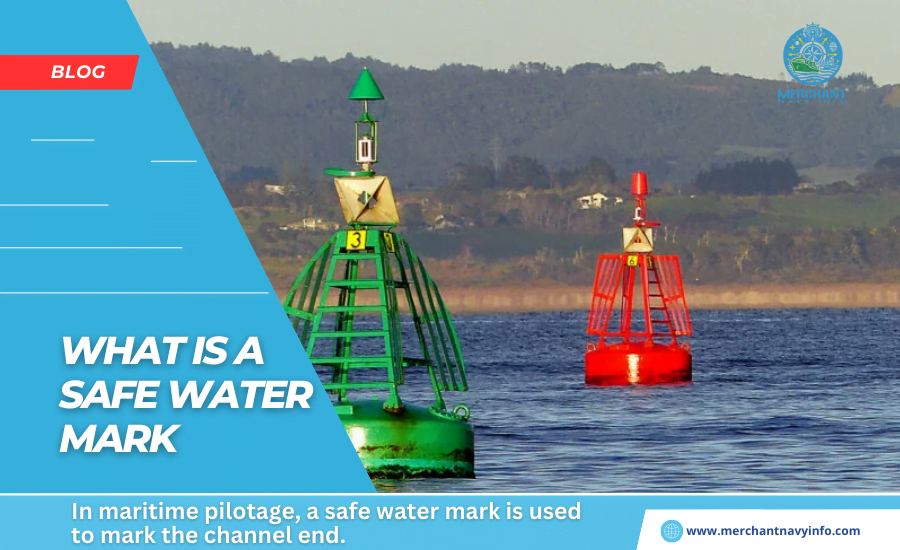
In the maritime industry, there are two things given paramount importance. These include navigation and communication. In order for these to be carried out with efficiency, certain documents must be maintained. For that to happen, we’re going to need to understand what safe water marks are and how they’re used in the maritime industry.
There’s one thing you need to understand. Safe water marks are mainly used to determine the authenticity of maritime documents. With so many shipments and literal global trade at stake, it’s obvious that the industry is going to need some sort of safeguard to ensure the authenticity of their documents.
What is a safe water mark in the maritime industry?

In the maritime industry, a safe water mark is known as a security feature. It’s present in important documents to verify their authenticity. Such documents include maritime charts, legal papers, and certificates. Now, traditional water marks are often present in the form of logos. These logos are often present on corners of the document.
However, in the maritime industry, they take it a step further. A safe water marker is often a digital or chemical marker. This is embedded into the fabric of the paper itself. This makes it almost impossible to replicate, which further helps the industry to escape counterfeiting. It also aids authorities while checking for tamper detection.
Importance of safe water mark in the maritime industry:
- Document authentication: This just might be the most important use of a safe water mark. They help to maintain the authenticity of documents. Important documents might include navigation charts, cargo manifests and even crew certifications. These watermarks help to negate the use of forged documents in the maritime industry.
- Security and tamper detection: Thanks to safe water marks, authorities are able to detect any attempts at creating forged documents. They make it impossible to tamper with existing documents as well. Since they are integrated into the fabric of the paper itself, it makes it impossible to forge the documents.
- Compliance with regulations: The maritime industry has a bunch of regulations and policies that must be followed. Thanks to safe water marks, the integrity of these documents is maintained. The relevant authorities publish and maintain these policies.
- Protection against piracy: They also help to protect against piracy. Maritime piracy affects certain regions in the world.A safe water mark allows the crew to protect themselves against potential piracy attacks. This also allows them to maintain the security onboard their vessels.
Benefits of implementing safe water marks in the maritime industry:

- Enhanced security and safety: If maritime officers integrate safe water marks into their documents, they can bolster security. This allows maritime stakeholders to be able to maintain the authenticity of critical documents. It also helps to prevent unauthorized access to maritime documents.
- Facilitation of digital transformation: As there are more advancements to technology, the maritime industry will continue to evolve as well. This means that they’ll have a higher dependance on digital documents. Safe water marks will help to maintain their integrity and authenticity. It’ll also help to reduce dependency on paper-based processes.
- Streamlined compliance and auditing: Safe water marks allow for higher efficiency when auditing documents. This helps to streamline the process of compliance verification for regulatory authorities and maritime stakeholders. Again, this helps in authenticating documents with ease.
- Protection of intellectual property: if we haven’t mentioned this enough times already, safe water marks help to prevent piracy. One can protect sensitive documents with it. Maritime authorities are able to prevent the illegal distribution of such documents as well. Overall, it acts as a great security measure.
How implement safe water marks effectively in maritime operations:

- Choose the right technology: You’re going to want to choose a reliable provider for your safe water marks. They’re going to need to provide a safe water mark that manages to meet industry standards. Other features that need to be present include robust encryption algorithms and industry compliant formats.
- Integrate with document management systems: In order to allow safe water marks to be of any use, you’re going to need to integrate it with existing document management systems. It will integrate seamlessly into the existing workflows. Furthermore, it’ll allow for efficient deployment across maritime organizations.
- Train personnel and stakeholders: An important thing to work on is training industry personnel. You’re going to want to focus on making them aware of the importance of safe water marks. You’re also going to want to ensure they know how to put them to use in the proper manner.
- Regular monitoring and auditing: The industry is going to have to implement policies to carry out regular monitoring and auditing of documents. As mentioned before, safe water marks will ensure this process occurs more efficiently. This will also help to point out any holes in security on an immediate basis.
- Collaborate with regulatory authorities: It’s important to collaborate with regulatory authorities to ensure a streamlined workflow across the industry. It will also help to ensure consistency across the maritime industry. It’s important to collaborate in this way to introduce necessary policies with greater ease.
Outro:
There you have it folks. That was a deep dive into why the maritime industry is in dire need of increased use of safe water marks. They help to maintain the integrity of critical documents. This in turn helps to increase the effectiveness of security measures in the industry. Since it’s responsible for so much of the world’s trade, these marks are of paramount importance.
By incorporating chemical or digital markers into documents, it helps with a plethora of security threats. It ensures protection against threats such as piracy, fraud and document forgery. Everyday, safe water marks become increasingly important for transporting such valuable information and other assets with them.










